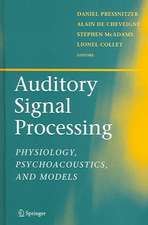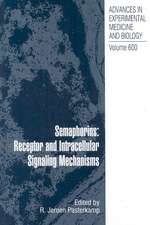Brain Network Dysfunction in Neuropsychiatric Illness: Methods, Applications, and Implications
Editat de Vaibhav A. Diwadkar, Simon B. Eickhoffen Limba Engleză Paperback – 12 mai 2022
Additional chapters provide details on how these methods are (and can be) applied in the understanding of several neuropsychiatric disorders, including schizophrenia, mood disorders, autism, borderline personality disorder, and attention deficit hyperactivity disorder (ADHD). A final complement of chapters provides a collective overview of how this framework continues to provoke theoretical advances in our conception of the brain in psychiatry. This unique volume is designed to be a comprehensive resource for imaging researchers interested in psychiatry, and for psychiatrists interested in advanced imaging applications.
| Toate formatele și edițiile | Preț | Express |
|---|---|---|
| Paperback (1) | 1664.74 lei 6-8 săpt. | |
| Springer International Publishing – 12 mai 2022 | 1664.74 lei 6-8 săpt. | |
| Hardback (1) | 1668.70 lei 6-8 săpt. | |
| Springer International Publishing – 12 mai 2021 | 1668.70 lei 6-8 săpt. |
Preț: 1664.74 lei
Preț vechi: 2030.18 lei
-18% Nou
Puncte Express: 2497
Preț estimativ în valută:
318.55€ • 347.10$ • 268.42£
318.55€ • 347.10$ • 268.42£
Carte tipărită la comandă
Livrare economică 23 aprilie-07 mai
Preluare comenzi: 021 569.72.76
Specificații
ISBN-13: 9783030597993
ISBN-10: 3030597997
Ilustrații: XVII, 488 p. 79 illus., 72 illus. in color.
Dimensiuni: 155 x 235 mm
Greutate: 0.77 kg
Ediția:1st ed. 2021
Editura: Springer International Publishing
Colecția Springer
Locul publicării:Cham, Switzerland
ISBN-10: 3030597997
Ilustrații: XVII, 488 p. 79 illus., 72 illus. in color.
Dimensiuni: 155 x 235 mm
Greutate: 0.77 kg
Ediția:1st ed. 2021
Editura: Springer International Publishing
Colecția Springer
Locul publicării:Cham, Switzerland
Cuprins
Table of Contents
1. Introduction
By Vaibhav A. Diwadkar & Simon B. Eickhoff, Detroit USA & Juelich Germany
A. Methods
2. fMRI: Blood Oxygen Level Dependent Contrast and Its Value for Understanding Functioning Brain
Networks
By Peter Bandettini, Maryland USA
3. Review of Resting-State Functional Connectivity Methods and Application in Clinical Populations
By Bharat Biswal, New Jersey USA
4. Directed Interregional Brain Interactions BY Steven Bressler, Boca Raton USA
5. Meta-analytic connectivity modelling (MACM): A tool for assessing regionspecific functional connectivity patterns in task-constrained states
By Robert Langner & Julia A. Camilleri, Dusseldorf Germany
6. dMRI: Diffusion Magnetic Resonance Imaging as a Window onto Structural Brain Networks and
White Matter Microstructure
By Alard Roebroeck, Maastricht Netherlands
7. Data Mining in the Era of Big Data: The BrainMap Database as a Resource for Characterizing
Psychiatric Illness
By Katherine L. Bottenhorn & Angela R. Laird, Miami USA
8. Network modulation in neuropsychiatric disorders using The Virtual Brain By Andrea B. Protzner, Sora An, & Viktor Jirsa, Calgary Canada & Marseille France
B. Applications
9. Networks-mediated spreading of pathology in neurodegenerative diseases
By Yasser Iturria-Medina & Alan C. Evans, Montreal Canada
10. Resting-State Functional Network Disturbances in Schizophrenia
By Qingbao Yu & Vince D. Calhoun, Albuquerque USA & New Haven USA
11. Disturbed Brain Networks in the Psychosis High-Risk State?
By André Schmidt & Stephan Borgwardt, Basel Switzerland
12. Functional Connectivity in Autism Spectrum Disorders: Challenges and Perspectives By Ralph-Axel Müller & Annika Linke, San Diego USA
13. Functional Resting-State Network Disturbances in Bipolar Disorder
By Gwladys Rey, Camille Piguet, & Patrik Vuilleumier, Geneva Switzerland
14. An overview of resting state functional connectivity studies of major depressive disorder
By Henry Chase, Pittsburgh USA
15. Brain network dysfunction in bipolar disorder: evidence from structural and functional MRI
studies
By Giuseppe Delvecchio, Eleonora Maggioni, Letizia Squarcina, & Paolo Brambilla
Milan Italy
16. Understanding the Network Bases of ADHD: An Overview of the fMRI Evidence By Samuele Cortese, Southampton UK
17. Cortical-Limbic and Default Mode Networks in Borderline Personality Disorder
By Annegret Krause-Utz & Christian Schmahl, Mannheim Germany
18. Structural and Functional Connectivity Changes Following Cognitive Remediation: A systematic
review
By New Fei Ho, Jordon XJ Tng, June Su Tan, & Kang Sim, Singapore
C. Implications
19. Single-Subject Prediction: A Statistical Paradigm for Precision Psychiatry
Danilo Bzdok & Teresa M. Karrer, Aachen Germany
20. Genetic Imaging: Promises and Pitfalls Thomas Nickl-Jockschat & Tom Wassink, Iowa City USA
21. Brain networks and the emergence of the Self: A neurophenomenal perspective
Georg Northoff, Ottawa Canada
22. Research Domains and Brain Network Dysfunction: Toward a New Taxonomy of
Neuropsychiatric Illness
Sophia Frangou, New York USA
1. Introduction
By Vaibhav A. Diwadkar & Simon B. Eickhoff, Detroit USA & Juelich Germany
A. Methods
2. fMRI: Blood Oxygen Level Dependent Contrast and Its Value for Understanding Functioning Brain
Networks
By Peter Bandettini, Maryland USA
3. Review of Resting-State Functional Connectivity Methods and Application in Clinical Populations
By Bharat Biswal, New Jersey USA
4. Directed Interregional Brain Interactions BY Steven Bressler, Boca Raton USA
5. Meta-analytic connectivity modelling (MACM): A tool for assessing regionspecific functional connectivity patterns in task-constrained states
By Robert Langner & Julia A. Camilleri, Dusseldorf Germany
6. dMRI: Diffusion Magnetic Resonance Imaging as a Window onto Structural Brain Networks and
White Matter Microstructure
By Alard Roebroeck, Maastricht Netherlands
7. Data Mining in the Era of Big Data: The BrainMap Database as a Resource for Characterizing
Psychiatric Illness
By Katherine L. Bottenhorn & Angela R. Laird, Miami USA
8. Network modulation in neuropsychiatric disorders using The Virtual Brain By Andrea B. Protzner, Sora An, & Viktor Jirsa, Calgary Canada & Marseille France
B. Applications
9. Networks-mediated spreading of pathology in neurodegenerative diseases
By Yasser Iturria-Medina & Alan C. Evans, Montreal Canada
10. Resting-State Functional Network Disturbances in Schizophrenia
By Qingbao Yu & Vince D. Calhoun, Albuquerque USA & New Haven USA
11. Disturbed Brain Networks in the Psychosis High-Risk State?
By André Schmidt & Stephan Borgwardt, Basel Switzerland
12. Functional Connectivity in Autism Spectrum Disorders: Challenges and Perspectives By Ralph-Axel Müller & Annika Linke, San Diego USA
13. Functional Resting-State Network Disturbances in Bipolar Disorder
By Gwladys Rey, Camille Piguet, & Patrik Vuilleumier, Geneva Switzerland
14. An overview of resting state functional connectivity studies of major depressive disorder
By Henry Chase, Pittsburgh USA
15. Brain network dysfunction in bipolar disorder: evidence from structural and functional MRI
studies
By Giuseppe Delvecchio, Eleonora Maggioni, Letizia Squarcina, & Paolo Brambilla
Milan Italy
16. Understanding the Network Bases of ADHD: An Overview of the fMRI Evidence By Samuele Cortese, Southampton UK
17. Cortical-Limbic and Default Mode Networks in Borderline Personality Disorder
By Annegret Krause-Utz & Christian Schmahl, Mannheim Germany
18. Structural and Functional Connectivity Changes Following Cognitive Remediation: A systematic
review
By New Fei Ho, Jordon XJ Tng, June Su Tan, & Kang Sim, Singapore
C. Implications
19. Single-Subject Prediction: A Statistical Paradigm for Precision Psychiatry
Danilo Bzdok & Teresa M. Karrer, Aachen Germany
20. Genetic Imaging: Promises and Pitfalls Thomas Nickl-Jockschat & Tom Wassink, Iowa City USA
21. Brain networks and the emergence of the Self: A neurophenomenal perspective
Georg Northoff, Ottawa Canada
22. Research Domains and Brain Network Dysfunction: Toward a New Taxonomy of
Neuropsychiatric Illness
Sophia Frangou, New York USA
Notă biografică
Dr. Vaibhav Diwadkar is Professor of Psychiatry & Behavioral Neurosciences at Wayne State University School of Medicine. He received his B.A. in Psychology and Computer Science from Coe College, and his PhD in Psychology and Cognitive Science from Vanderbilt University. Following neuroimaging-related fellowships at Carnegie Mellon University and the University of Pittsburgh, he has served on the faculty of the University of Pittsburgh, and at Wayne State University where he has been since 2005. He uses in vivo neuroimaging to understand mechanisms of brain network function (underlying psychological and physiological processes), publishing in the areas of learning, memory, cognition and sensorimotor function, and thermoregulation. His clinical neuroimaging interests lie in understanding brain network dysfunction in psychiatry, leading to publications on schizophrenia, mood disorders, obsessive compulsive disorder, and borderline personality disorder. His research is supported by the National Institutes of Mental Health, the Children's Research Center of Michigan, the Children’s Hospital of Michigan Foundation, the Ethel and James Flinn Foundation, the DMC Foundation, the Cohen Neuroscience Endowment, the Prechter World Bipolar Foundation, the Jack Dorsey Endowment, and the National Alliance for Research on Schizophrenia and Depression (now the Brain and Behavior Research Foundation).
Simon Eickhoff is a full professor and chair of the Institute for Systems Neuroscience at the Heinrich-Heine University in Düsseldorf and the director of the Institute of Neuroscience and Medicine (INM-7, Brain and Behavior) at the Forschungszentrum Jülich. He is furthermore a visiting professor at the Chinese Academy of Science Institute of Automation. Workig at the interface between neuroanatomy, data-science and brain medicine, the he aims to obtain a more detailed characterization of the organization of the human brain and its inter-individual variability in order to better understand its changes in advanced age as well as neurological and psychiatric disorders. This goal is pursued by the development and application of novel analysis tools and approaches for large-scale, multi-modal analysis of brain structure, function and connectivity as well as by machine-learning for single subject prediction of cognitive and socio-affective traits and ultimately precision medicine.
Simon Eickhoff is a full professor and chair of the Institute for Systems Neuroscience at the Heinrich-Heine University in Düsseldorf and the director of the Institute of Neuroscience and Medicine (INM-7, Brain and Behavior) at the Forschungszentrum Jülich. He is furthermore a visiting professor at the Chinese Academy of Science Institute of Automation. Workig at the interface between neuroanatomy, data-science and brain medicine, the he aims to obtain a more detailed characterization of the organization of the human brain and its inter-individual variability in order to better understand its changes in advanced age as well as neurological and psychiatric disorders. This goal is pursued by the development and application of novel analysis tools and approaches for large-scale, multi-modal analysis of brain structure, function and connectivity as well as by machine-learning for single subject prediction of cognitive and socio-affective traits and ultimately precision medicine.
Textul de pe ultima copertă
Brain network function and dysfunction is the dominant model for understanding how the brain gives rise to normal and abnormal behavior. Moreover, neuropsychiatric illnesses continue to resist attempts to reveal an understanding of their bases. Thus, this timely volume provides a synthesis of the uses of multiple analytic methods as they are applied to neuroimaging data, to seek understanding of the neurobiological bases of psychiatric illnesses, understanding that can subsequently aid in their management and treatment. A principle focus is on the analyses and application of methods to functional magnetic resonance imaging (fMRI) data. fMRI remains the most widely used neuroimaging technique for estimating brain network function, and several of the methods covered can estimate brain network dysfunction in resting and task-active states.
Additional chapters provide details on how these methods are (and can be) applied in the understanding of several neuropsychiatric disorders, including schizophrenia, mood disorders, autism, borderline personality disorder, and attention deficit hyperactivity disorder (ADHD). A final complement of chapters provides a collective overview of how this framework continues to provoke theoretical advances in our conception of the brain in psychiatry. This unique volume is designed to be a comprehensive resource for imaging researchers interested in psychiatry, and for psychiatrists interested in advanced imaging applications.
Additional chapters provide details on how these methods are (and can be) applied in the understanding of several neuropsychiatric disorders, including schizophrenia, mood disorders, autism, borderline personality disorder, and attention deficit hyperactivity disorder (ADHD). A final complement of chapters provides a collective overview of how this framework continues to provoke theoretical advances in our conception of the brain in psychiatry. This unique volume is designed to be a comprehensive resource for imaging researchers interested in psychiatry, and for psychiatrists interested in advanced imaging applications.
Caracteristici
Combines and synthesizes expertise from neuroimaging and psychiatry
Discusses applications of neuroimaging to reveal dysfunctional brain networks interactions in specific neuropsychiatric disorders
Explores the implications of research findings for understanding the mechanistic bases of various diseases and for their management and treatment
Discusses applications of neuroimaging to reveal dysfunctional brain networks interactions in specific neuropsychiatric disorders
Explores the implications of research findings for understanding the mechanistic bases of various diseases and for their management and treatment





















